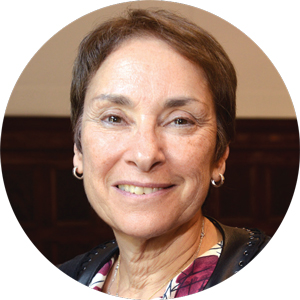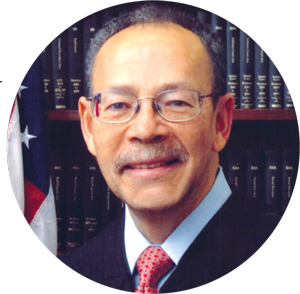Trending
The judges who rule over real estate
In the Supreme Court’s ‘crowned jewel’ division, several key justices wield</br>the gavel on some of the</br> industry’s biggest cases

When a New York real estate deal goes south or a partnership sours, chances are good that someone is going to court. And if the stakes are high enough, there’s a strong likelihood that the case will end up in the Commercial Division of the New York Supreme Court in Manhattan.
Indeed, the judges that rule in these parts have some serious decision-making power when it comes to big-ticket New York City real estate cases.
But while litigious real estate players fill out much of their dockets, commercial judges hear an impressively wide range of cases (recent suits include big-box retailers fighting over Martha Stewart-brand bath towels and the pop star Kesha seeking to cut ties with hit record producer Dr. Luke).
The division, which is housed at 60 Centre Street, less than a mile from Wall Street, is where spats over billions of dollars in securities were first heard when markets crashed during the Great Recession.
“They have a tremendous caseload,” said defense attorney Stuart Slotnick, who referred to the Commercial Division as the “crown jewel” of the Supreme Court system. “They frequently have what we call ‘bet the farm’ cases — high-dollar cases.”
To be eligible for the commercial division, a suit must carry a price tag of at least $500,000 — a number that’s gone up considerably over the years. Because of the dollar threshold, as well as the experience these judges have with high-stakes cases, many litigants check off the “commercial” box when filing a big-time real estate lawsuit. (The court ultimately decides where cases are heard.)
“Our real estate cases almost exclusively start at, or are housed within, the Commercial Division,” said attorney Lori Marks-Esterman of Olshan Frome Wolosky. “The commercial division judges are very familiar with real estate disputes and the players and the practicalities that go with New York State real estate litigation, as well as the implications.”
In New York, Supreme Court judges are usually elected in partisan elections — though some are assigned as “acting” judges. Of the nine on the bench, most have at some point been affiliated with the Democratic Party.
Herrick Feinstein real estate litigator Ray Hannigan said the Commercial Division is a huge asset in a sophisticated market like New York, where real estate disputes can be particularly complex.

Judge Jeffrey Oing
“Thank the lord for the Commercial Division,” he said. “It’s very nice that you’re able to go into a part where the judges have tremendous experience in dealing with complex agreements and complex issues and don’t need a lot of time to get up to speed because they’ve seen it all before.”
Not surprisingly, real estate attorneys who regularly appear before these judges have strong opinions of them — and seem to revel in exchanging intel. And they do so in force on the Robing Room, a website that lets lawyers anonymously rate judges and post reviews of them.
While some judges are known for being meticulous or pushing cases toward settlement, others are said to ignore case papers or mete out biased treatment.
This month, The Real Deal profiled six of the nine judges on the Supreme Court’s Commercial Division bench — focusing on those who have overseen some of the city’s biggest real estate cases in the last few years. Read on for a closer look at the hands wielding the gavel.
Judge Jeffrey Oing
Justice Oing reportedly grew up playing on the courthouse steps as kid, attending Sunday school in nearby Chinatown.
First elected to the Supreme Court bench in 2010, Oing has heard a large number of notable real estate cases. Highlights include a suit filed by entrepreneur Avi Dorfman against Urban Compass (now known as Compass) over the firm’s alleged theft of trade secrets, a family feud between the principals of Sitt Asset Management and a falling out between Kuafu Properties and partners — disgraced developer Sean Ludwick’s Blackhouse Development and Siras Development — on the hotel-and-condo project known as Hudson Rise on the Far West Side.
Oing — who joined the Commercial Division in 2011 — has a reputation as not just thorough and hardworking but also for keeping it lighthearted on the bench.
“He’s like a law geek, and I say that with immense respect,” said attorney Janice Mac Avoy, who heads Fried Frank’s real estate litigation practice and has represented firms such as Boston Properties and Lehman Brothers.
For his part, Oing told TRD that he “loves oral argument” and that he “drives a hard case.”
“It gives the lawyers a chance to show what they’ve got,” said Oing, who when reached by phone began enthusiastically recounting his most recent decision. “If the lawyers are really good, I’ve been persuaded to go the other way.”
Mac Avoy said Oing thrives on the banter with counsel and can often be spotted smiling during proceedings.
“It’s actually fun watching him,” she said. “If there were a courtroom scene on TV, it would be in Judge Oing’s courtroom.”
 Real estate attorney Adam Leitman Bailey has similar impressions of Oing, calling him a “terrific judge” and a “great listener” as well as a “very good writer.”
Real estate attorney Adam Leitman Bailey has similar impressions of Oing, calling him a “terrific judge” and a “great listener” as well as a “very good writer.”
But Oing has shown that he’s willing to break with his affable reputation.
In a 2014 decision on a case between department store giants Macy’s and JCPenney, Oing said that JCPenney’s CEO Ron Johnson had displayed “sophomoric” and “childish behavior” in attempting to strike a special agreement with Martha Stewart to sell branded products that were already licensed to Macy’s.
Oing said Johnson was a “casualty of his own hubris,” adding that on Johnson’s watch, executives at the department store had participated in “adolescent hijinks in the worst form.” It would seem that Oing is as much a lover of descriptive language as he is of law.
Judge Charles Ramos
Of all the judges in the Commercial Division, Justice Ramos may be the most feared.
First elected to the Supreme Court in 1993, he has served on the court’s Commercial Division bench for 20 years. In that time, he has presided over innumerable real estate matters, with recent cases involving giant commercial landlords (like SL Green Realty) and major commercial brokerages (like Eastern Consolidated).
In 2014, Ramos lit up the tabloids when he ruled MSNBC host Donny Deutsch had stiffed Sotheby International Realty broker Edward Petrie out of a $1.2 million commission on the $30 million sale of his Hamptons home. In his decision, Ramos wryly referred to Deutch’s “dishonesty and greed” as “particularly unbecoming when exhibited by those blessed with great wealth.”
But Ramos seems to have a record of ticking off attorneys that is unparalleled in this division.
“He’s kind of a wild card,” said one attorney who would only speak on the condition of anonymity. “He’s emotional, he rules from the hip and he doesn’t read the papers,” the attorney said.
Ramos did not respond to requests for comment, but on the Robing Room users called out the judge for the same issues. “[He never bothered to read the materials, wasting YEARS of my life,” one user wrote.
Some see this portrayal as a complete misunderstanding of Ramos’ operating procedure.

Judge Charles Ramos
Herrick Feinstein real estate litigator Ray Hannigan said Ramos’ tendency to read over case papers during proceedings is not for lack of preparation.
“To be able to sit there in the middle of a hot argument to review key provisions, stop the court, take some time and try to understand and usually get it right, I think, is quite a skill,” he said. “I think it’s an advantage that he can refer to documents on the spot.”
Slotnick, a well-known white-collar defense lawyer, also dismissed the notion that Ramos comes unprepared, calling him “the real deal.” But he said he understands why some attorneys don’t have a warm and fuzzy feeling about him.
“He can be a little tough if he thinks your argument is not serious,” Slotnick said.
Hannigan noted that Ramos is gifted at engaging in heated arguments.
“There was one time where we were three-quarters into an argument and I thought I was winning,” Hannigan recalled, “and the next thing you know Ramos started to skewer me, and it took quite the effort to get back on the winning side of the column.”
At least one defendant, though, has cited Ramos’ argumentativeness as reason to have him benched from a case. Former executives at insurance giant AIG filed to have him removed in 2013 when the New York State attorney general took the company to court over reinsurance deals alleged to be fraudulent. AIG accused Ramos of being “aggressive and argumentative” and claimed Ramos had formed his opinions based on hearings in a different case, indicating a bias against AIG.
That wasn’t the only time AIG tried to oust Ramos. In an unrelated suit, regarding sex abuse settlements paid out by the Horace Mann School, which AIG refused to reimburse, AIG once again sought recusal for Ramos — this time because he was an alumni of the famed prep academy.
“He’s the guy every attorney’s afraid of,” said another lawyer, too timid to share his name in print.
Judge Shirley Kornreich
In 2014, Gerald Rosengarten, the man who popularized the “leisure suit” in the 1970s, sued his Bowery Hotel co-owner Richard Born, the celebrity hotelier who claims he invented the “boutique hotel.”
In his $50 million suit, Rosengarten alleged that Born cut him out of deals to sell apartments at the hotel.
When the court ordered Born to provide email exchanges, his defense team reportedly turned over more than 500,000 pages of documents, many of them irrelevant to the case. In response to this, Justice Kornreich did not mince words. She called the defense “contumacious” (i.e., willfully disobedient) and said the “document dump” was “inexcusable.”
Herrick Feinstein’s Hannigan said Kornreich and her staff are very focused on “modern issues of electronic discovery.”
“Her part [of the Court] is very sophisticated, very much like a federal court in some ways,” he said, adding that in most state courtrooms, there simply isn’t enough time to take on deep and careful electronic tracking. “You have to be very prepared,” he said.
Kornreich, a graduate of New York University and its law school, was first elected to the Civil Court in 1994.

Judge Shirley Kornreich
She was appointed to the Supreme Court in 2002 and has served on the Commercial Division bench since 2009.
In New York real estate circles, Kornreich is known for her handling of class-action lawsuits filed in the aftermath of Hurricane Sandy.
In late 2013 and early 2014, she ruled in favor of several landlords in class-action complaints filed by tenants seeking rent refunds. In her decision, Kornreich explained that suing as a group was problematic because not all apartments were impacted by utilities outages and other hurricane damage in the same way.
As for Kornreich’s reputation among attorneys, she is known for preparedness and for her quick dismissal of “contumacious” behavior.
“She takes no prisoners, and she takes no crap,” said Bailey, noting that she is “very smart.”
“If a lawyer is wasting time, she’ll make clear she’s not going to put up with that,” he said.
Fried Frank’s Mac Avoy has a similar take. “[She’s] very courteous and very respectful, [but] at the same time I have seen her sanction people for inappropriate conduct and it’s been awesome to watch,” she said.
Still, she gives everyone a fair shake, sources said. “I’ve seen her be persuaded by what a lawyer said at oral arguments,” Mac Avoy said.
While many of her positive traits are mentioned on the Robing Room, Kornreich is also singled out for a sharp tongue and a stern approach.
“Her intelligence is at odds with her flaws,” wrote one civil litigation attorney, who called Kornreich “irascible” and “short-tempered.”
Judge Marcy Friedman
Although Justice Friedman is just shy of four years in the Commercial Division, she has more experience overseeing real estate cases than almost anyone on the bench.
Appointed as a housing court judge in 1991, Friedman developed a reputation as a fervent defender of tenant rights. She joined the Supreme Court in 2000, hearing, among other things, torts and commercial cases, including many in real estate.
In 2010, Friedman issued a crucial rent-stabilization decision.
The case involved a move by Laurence Gluck’s Stellar Management to deregulate units at its giant 1,331-unit complex Independence Plaza North in Tribeca while also receiving the J-51 tax abatement. Stellar notified the city that it wanted to stop receiving the tax abatement so that it could begin destabilizing rent-regulated apartments. But the government mistakenly kept the benefits going for two years and tenants argued that their units had therefore been illegally destabilized. Friedman decided that the tenants were indeed entitled to rent-stabilization.
But just two years later, the Appellate Court knocked Friedman’s ruling down. Gluck also paid back the J-51 benefits he received.

Judge Marcy Friedman
Bailey, who represents both tenants and landlords, described Friedman as “very, very pro-tenant” while she was a housing court judge but said that changed once she joined the Supreme Court. “She got rid of her bias completely,” he said.
Since joining the Commercial Division, Friedman has heard a number of residential mortgage-backed securities cases in which RMBS investors who saw their money evaporate during the financial crisis filed claims against banks, alleging that the financial institutions had not properly outlined the risks in offering materials.
While Friedman has thrown out some RMBS cases, she’s also notably rejected defendants’ attempts to dismiss these cases — like when New York Attorney General Eric Schneiderman sued CreditSuisse alleging RMBS fraud totaling $10 billion. CreditSuisse argued that it was too late to sue, but Friedman begged to differ and the case is still ongoing.
In 2013, the New York Supreme Court issued an order to have all future RMBS cases alleging wrongdoing by the issuer sent to Friedman.
Several attorneys described Friedman as a master diplomat, known for aggressively urging parties to settle out of court.
“Litigation is a very expensive vehicle to resolve differences,” said real estate attorney Gary Wachtel. “She tries to get attorneys to see the forest through the trees in an effort to settle cases.”
Bailey said Friedman’s “intelligence and analytical thinking” helps “in getting cases resolved and helps her ferret out frivolous claims.”
Judge O. Peter Sherwood
Justice O. Peter Sherwood has held more public positions in law than perhaps many people know exist.
From 1986 to 1991, he served as New York State’s solicitor general. From there he went on to work for then-mayor David Dinkins as chief attorney, making diversity among his legal staff a top priority.
Over the years, he’s also sat on several boards and commissions. In 2008, he was nominated as a judge to the Court of Claims by then-Governor David Patterson. He is now an acting judge of the Commercial Division.
Recent cases from the Sherwood docket include favorable decisions for some marquee real estate machers.
In 2013, he sided with the Malkins in their move to consolidate 19 properties —among them the Empire State Building — into a publicly traded company known as the Empire State Realty Trust. (Sherwood dismissed one shareholder complaint in the case and mediated a $55 million settlement in another.)
Meanwhile, in 2012, Sherwood decided in favor of real estate titan Rubin Schron when he sued partners intent on preventing him from exercising an option to sell two nursing homes.

Judge O. Peter Sherwood
And back in 2010, Sherwood made industry news when he rejected a petition from a neighborhood group seeking to stop the development of the Jean Nouvel-designed MoMa Tower at 53 West 53rd Street, a high-rise currently rising adjacent to the Museum of Modern Art.
Shaun Pappas, a lawyer at Starr Associates, said attorneys expecting to pay Sherwood a visit in the near future would benefit from staying on top of relevant case law. According to Pappas, Sherwood is unique among other Commercial Division judges for his erudite knowledge of recent decisions (as fresh as the last couple of months).
“He’ll ask you about cases that are newer,” said Pappas, who’s appeared before Sherwood on several occasions. “He wants to know that you understand where the case law is and where it’s heading.”
Olshan Frome Wolosky attorney Lori Marks-Esterman said that while Sherwood is “a very vocal judge” who will “jump right in and take control of his courtroom,” he has a “mild disposition” and is “not a yeller.”
Both Pappas and Marks-Esterman noted that he closely reads case documents. And if an attorney uses his or her oral arguments to simply recite what’s already written in case papers, Sherwood will not have it.
“My instinct is that the lawyers [with negative reviews] tried to B.S. Judge Sherwood,” said one Robing Room user. “He has no patience for that.”
Judge Saliann Scarpulla
She’s only served in the Commercial Division for two years, but Justice Scarpulla is short on neither experience nor reputation.
Scarpulla — a former private practice litigator and senior counsel at the FDIC —was first elected to the Civil Court in 2001. In 2009, she was made an “acting” Supreme Court Justice, and she was elected in 2012. In 2014, she was assigned to the Commercial Division.
Since joining the Supreme Court, Scarpulla has had the last word on several notable cases.
While still a rookie Supreme Court judge in 2010, she came down against the Metropolitan Transportation Authority, ruling that the agency had acted illegally when it laid off more than 200 workers and closed customer-assistance booths without holding required public hearings. She ruled that they had to reopen the booths and staff them.
A few years later, in 2013, Scarpulla sided with an Upper West Side resident over a landlord in another J-51 tax case. The resident was later awarded close to $900,000 in rent overcharges by another judge in what was one of the largest, if not the largest, paybacks to a single tenant in a rent-stabilization case.

Judge Saliann Scarpulla
The following year, meanwhile, Scarpulla sided with Bank of America when AIG was looking to delay (and increase) the bank’s $8.5 billion settlement to investors who had bought Countrywide-issued mortgage-backed securities. (AIG was one of over 20 institutional investors that lost its shirt on the deal.)
And Scarpulla is known for keeping cases on the fast track.
“She really runs a tight ship with regards to keeping people on a strict discovery schedule,” said Pappas. “Defendants sometimes want to delay, delay, delay … she has an eye on making sure that the case is moving forward and progressing.”
Olshan Frome’s Marks-Esterman — who recalled a five-year-old case that was resolved expeditiously once it landed in Scarpulla’s courtroom — agreed. “[She has] a desire to push for a resolution, to cut right to the chase,” she said.
Scarpulla has one of the highest ratings of any of the Commercial Division judges on the Robing Room, with a 6.2 out of 10 average ranking.
One commenter praised her ability to rule “swiftly.” Others said that she’s “not a pushover, and not a monster” and is “truly a rising star.” Dissenting opinions of Scarpulla are far less detailed, but “rude” and “dense” are recurring themes.
Like some other judges in the division, Scarpulla is known for a direct, tell-it-like-it-is style.
“There’s not a chance in hell I would issue that [temporary restraining order],” Scarpulla once told lawyers for the Corcoran Group, who sought to bar former Soho manager Gene Martinez from working for his new firm, Compass, after he was poached by the competing brokerage.
“Corcoran, the biggest real estate broker in the state of New York, is coming to me and saying that ‘we need protection from this new start-up company?’” Scarpulla said in court.
Defense attorney Slotnick, who was not involved in the Corcoran-Compass case, said Scarpulla does not hold back.
“If she hears an argument that is not a legitimate one, she’ll tell you,” he said.




